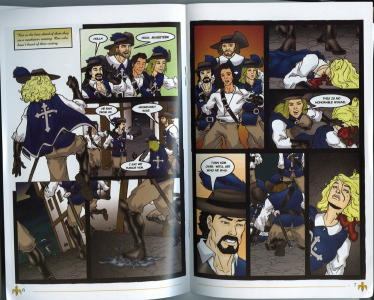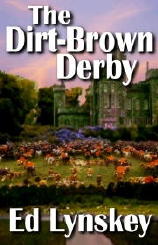January 2007
Monthly Archive
Thu 25 Jan 2007
If you’ve done any researching into matters bibliographical, you know how it goes. You’re looking up one thing, you find another. In the case at hand, I was trying to pin down some information on a performance of Wilkie Collins’ The Woman in White on TV in the early 1960s. I found it without too much trouble, but in the process I discovered that it happened to be an episode of a series that not only do I not ever remember seeing, I don’t even remember reading about it: The Dow Hour of Great Mysteries.
It was on, as it turns out, while I was off in college in a town so small that there we could get only one channel, and even though the local station was an NBC affiliate, I don’t remember taking very many study breaks to watch television. Except for Johnny Carson late at night, I do admit, thinking back upon it, every once in a while.
More investigating was in order. There’s nothing on the series in my only handy in-print resource, The Complete Directory to Prime Time Network TV Shows, 1946-Present, 3rd Edition, by Tim Brooks & Earle Marsh.
So it was off to the computer and www.imdb.com, and lo, there it is. Here’s a list of the titles of the stories that IMDB says were adapted:
The Dow Hour of Great Mysteries. A series of seven television specials hosted by John Welch.
Season 1, Episode 1: The Bat [Mary Roberts Rinehart]
Original Air Date: 31 March 1960
From
Time magazine April 4, 1960:
Dow Hour of Great Mysteries (NBC, 9-10 p.m.). The first of a series of classic mysteries adapted for TV. Mary Roberts Rinehart’s The Bat stars Helen Hayes and Jason Robards Jr. Host: Joseph Welch.
Season 1, Episode 2: The Burning Court [John Dickson Carr]
Original Air Date: 24 April 1960
Season 1, Episode 3: The Woman in White [Wilkie Collins]
Original Air Date: 23 May 1960
Season 1, Episode 4: The Dachet Diamonds [Richard Marsh]
Original Air Date: 20 September 1960
Season 1, Episode 5: The Inn of the Flying Dragon [Sheridan Le Fanu]
Original Air Date: 18 October 1960
Season 1, Episode 7: The Great Impersonation [E. Philips Oppenheim]
Original Air Date: 15 November 1960
But continuing on and doing some Googling around, I came up with the following, a short piece from the NY Times. Where does this fit in?
PLOT DESCRIPTION for Columbo [TV series]
It all began in 1960 as a stage play called “Prescription: Murder” written by whodunit enthusiasts Richard Levinson and William Link. Joseph Cotten starred as a prominent society doctor who smugly believed he had committed the perfect murder when he knocked off his wife. The detective assigned to the case was a slovenly, disorganized seemingly aphasic old coot played by Thomas Mitchell. Secure in the assumption that so cloddish and unprepossessing a detective would ever be smart enough to tumble to his guilt, the doctor allowed the elderly cop to engage in a game of cat and mouse as they affably discussed possible motives and methods related to the murder. But the doc had underestimated the detective, who had a mind like a steel trap, and by the end of the play had ever so politely and unassumingly allowed the murderer to hang himself with his own words. “Prescription Murder” never made it to Broadway, but Levinson and Link revived the property as a one-hour TV drama on the NBC anthology
The Dow Hour of Great Mysteries, with Bert Freed in the role of the unkempt but cagey detective, now named Lt. Columbo. [No date given.]
and this, also from a Time magazine TV column:
Tuesday, 09-27-60
The Dow Hour of Great Mysteries (NBC, 10-11 p.m.). The Cat and the Canary [John Willard, play]
It doesn’t make sense for me to try to put anything more together if a episode log has already been done. If someone’s already done one, please let me know about it. My attention has been gotten.
[UPDATE 01-25-07] To answer my own question, yes, according to the BFI website, “The Cat and the Canary” is a Dow program and correctly should be number five in the series, contrary to IMDB, with “The Inn of the Flying Dragon” number six.
Of course, to return to the theme I began at the beginning of this blog entry, while checking out the Dow series, I came across yet another series called Orson Welles’ Great Mysteries (1973-74), which is also not found in B&M, but is included on IMBD. What network it was on, or whether it was syndicated, I know nothing more.
Season 1, Episode 1: Captain Rogers
Original Air Date: 1 September 1973
Season 1, Episode 2: The Leather Funnel
Original Air Date: 8 September 1973
Season 1, Episode 3: A Terribly Strange Bed
Original Air Date: 15 September 1973
Season 1, Episode 4: La Grande Breteche
Original Air Date: 22 September 1973
Season 1, Episode 5: The Dinner Party
Original Air Date: 29 September 1973
Season 1, Episode 6: Money to Burn
Original Air Date: 6 October 1973
Season 1, Episode 7: In the Confessional
Original Air Date: 13 October 1973
Season 1, Episode 8: Unseen Alibi
Original Air Date: 20 October 1973
Season 1, Episode 9: Battle of Wits
Original Air Date: 27 October 1973
Season 1, Episode 10: A Point of Law
Original Air Date: 3 November 1973
Season 1, Episode 11: The Monkey’s Paw
Original Air Date: 10 November 1973
Season 1, Episode 12: The Ingenious Reporter
Original Air Date: 17 November 1973
Season 1, Episode 13: Death of an Old-Fashioned Girl
Original Air Date: 24 November 1973
Season 1, Episode 14: For Sale – Silence
Original Air Date: 1 December 1973
Season 1, Episode 15: The Inspiration of Mr. Budd
Original Air Date: 8 December 1973
Season 1, Episode 16: An Affair of Honour
Original Air Date: 15 December 1973
Season 1, Episode 17: Farewell to the Faulkners
Original Air Date: 22 December 1973
Season 1, Episode 18: The Power of Fear
Original Air Date: 29 December 1973
Season 1, Episode 19: Where There Is a Will
Original Air Date: 5 January 1974
Season 1, Episode 20: A Time to Remember
Original Air Date: 12 January 1974
Season 1, Episode 21: Ice Storm
Original Air Date: 19 January 1974
Season 1, Episode 22: Come Into My Parlor
Original Air Date: 26 January 1974
Season 1, Episode 23: Compliments of the Season
Original Air Date: 3 February 1974
Season 1, Episode 24: Under Suspicion
Original Air Date: 10 February 1974
Season 1, Episode 25: Trial for Murder
Original Air Date: 17 February 1974
Season 1, Episode 26: The Furnished Room
Original Air Date: 24 February 1974
I never saw this one, either. Whatever you can tell me about it would once again be appreciated.
[UPDATE: 01-26-07] Mark Murphy sent me an email which addresses two issues. The first one deals with the genesis of the Lt. Columbo character — as hard as it may be to believe, the piece quoted above from the New York Times has gotten several of its facts wrong. Mark has led me to enough information about the origins of the character that I’ve decided to make a separate post out it. Look for it soon.
Mark also goes on to say, and I’m quoting here:
I also remember the Orson Welles “Great Mysteries” shows. They were a half-hour, syndicated. I think they were done in England, with Welles doing the intros. I don’t remember being very impressed by them, but then I was a kid then.
“Great Mysteries” was one of a number of shows syndicators made money with when the FCC started its “family hour” rule. (I think that’s what it was called, though I could be wrong.)
As I recall, before this rule took effect, network programming ran from 7:30 p.m. to 11 p.m. The rule restricted it to 8 to 11 p.m. under the theory that local stations would produce local content to fill the extra half-hour. What they got was stuff like “Great Mysteries” and game shows.
Hope this helps, and I enjoyed your site.
Mark Murphy
Thank you, Mark. Yes, I remember when that “family hour” ruling came along, prompted by the FCC. It was early in 1975. Not only did it provide for the “family hour” between 7 pm and 8, but the network heads adopted a self-declared “family viewing” hour in the first hour of network evening prime-time (8:00-9:00 P.M., Eastern time). Quick to complain was Norman Lear producer of the popular but still controversial comedy, All in the Family. Follow the link to learn more about it.
[UPDATE 01-27-07] Taken from a followup email from Mark M. —
As I recall, our local NBC affiliate stuck the Orson Welles shows on on Sunday nights at 10:30; network programming on Sundays on those days was 7:30 to 10:30 p.m. I think the ABC affiliate did something similar with Roald Dahl’s
Tales of the Unexpected show.
I only recall two episodes of the Welles show. One, “The Inspiration of Mr. Budd,” was based on a Dorothy Sayers story. I think Hugh Griffith may have played the heavy. Another was based on a Stanley Ellin story, the twist being (as I recall) that the victim had accidentally stabbed herself to death.
Amazing how I can seem to recall stuff like this but can’t always remember where I left the remote control, or my keys….
Best,
Mark M.
That’s because those fellows have minds of their own. But all seriousness aside, it beginning to look as though someone (maybe even me) should do some annotations for the Orson Welles series. Who wrote the original stories, and who the cast members were for each episode, that sort of thing.
Yes, it’s probably all on IMDB, but you have to work to find it. Which is also probably why I won’t get to it right away, either.
Wed 24 Jan 2007
Most of the online sites that will be running obituaries of E(verette) HOWARD HUNT (Jr.) this week will concentrate on one thing and one thing only, and that is his involvement in the Watergate matter, a true focal point in this nation’s history. You say Watergate, and to everyone in the US who was more than eight years old at the time, what memories it brings.
It was from Bill Crider’s blog that I learned the news of Mr. Hunt’s death (and Bill learned it from someone else), and the link he provides from Yahoo! News begins this way:
MIAMI – E. Howard Hunt, who helped organize the Watergate break-in, leading to the greatest scandal in American political history and the downfall of Richard Nixon’s presidency, died Tuesday. He was 88.
Hunt died at a Miami hospital after a lengthy bout with pneumonia, according to his son Austin Hunt.
The elder Hunt was many things: World War II soldier,CIA officer, organizer of both a Guatemalan coup and the botched Bay of Pigs invasion, and author of more than 80 books, many from the spy-tale genre.
I’ll leave it to others to talk about the real life stuff. What I’ll do is see how many of the 80 books I can list, but counting only those from the spy-tale genre. Which, I hasten to add, were made all the more real by Mr. Hunt’s real-life background in matters of spying and inside-the-Beltway intrigue and adventure.
Source: Crime Fiction IV, by Allen J. Hubin.
As by E. HOWARD HUNT. Many of these are reprints of books published first under one of his several pseudonyms:
# On Hazardous Duty. Signet 1972; See: Signet, 1965 as by David St. John.
# Festival for Spies. Signet 1973; See: Signet, 1966 as by David St. John.
# My Body. Lancer 1973; See: Lancer, 1962 as by Robert Dietrich.
# One of Our Agents Is Missing. Signet 1973; See: Signet, 1967 as by David St. John.
# Where Murder Waits. Gold Medal 1973; See: Gold Medal, 1965 as by Gordon Davis.
# From Cuba with Love. Pinnacle 1974; See: Ring Around Rosy (Gold Medal 1964), as by Gordon Davis.
# Return from Vorkuta. Signet 1974; See: Signet, 1965 as by David St. John.
# The Towers of Silence. Signet 1974; See: Signet, 1966 as by David St. John.
# The Venus Probe. Signet 1974; See: Signet, 1966 as by David St. John.
# Counterfeit Kill. Pinnacle 1975; See: Gold Medal, 1963 as by Gordon Davis.
# Washington Payoff. Pinnacle 1975; See: House Dick (Gold Medal 1961), as by Gordon Davis.
# Izmir. Fine 1996 [Jack Novak; Miami, FL]
# Dragon Teeth. Dutton 1997 [Jack Novak; China]
# Guilty Knowledge. Forge 1999 [Steve Bentley; Washington, D.C.]
# Sonora. Dutton 2000 [Jack Novak; Mexico]
I have been meaning to track down a copy of that last appearance (in 1999) of swinging CPA-sleuth Steve Bentley, but so far I haven’t. I’ve often wondered how the gap of 37 years in Bentley’s life was filled in. Most of the Steve Bentley adventures were written as by Robert Dietrich. See below. Jack Novak is described in at least one book as a “rogue DEA agent.”
As by HOWARD HUNT:
* Maelstrom (n.) Farrar 1948 [Mexico]
* -Bimini Run (n.) Farrar 1949 [Ship]
* Dark Encounter (n.) Signet 1950; See: Maelstrom (Farrar 1948).
* The Violent Ones (n.) Gold Medal 1950 [Paris]
* The Judas Hour (n.) Gold Medal 1951 [Prague]
* Whisper Her Name (n.) Gold Medal 1952 [Cuba]
* Lovers Are Losers (n.) Gold Medal 1953 [Los Angeles, CA]
* Cruel Is the Night (n.) Berkley 1955; See: Maelstrom (Farrar 1948).
* Little Miss Murder (n.) Phantom 1956
* The Berlin Ending (n.) Putnam 1973 [Neil Thorpe]
* The Hargrave Deception (n.) Stein 1980
* The Gaza Intercept (n.) Stein 1981 [Middle East]
* Cozumel (n.) Stein 1985 [Jack Novak; Caribbean]
* The Kremlin Conspiracy (n.) Stein 1985 [Neil Thorpe; Moscow]
* Guadalajara (n.) Scarborough 1986 [Jack Novak; Mexico]
* Mazatlan (n.) Stein 1986 [Jack Novak; Mexico]
* Murder in State (n.) St. Martin’s 1990 [Washington, D.C.]
* Body Count (n.) St. Martin’s 1992
* Chinese Red (n.) St. Martin’s 1992
* Ixtapa (n.) Fine 1994 [Jack Novak; Mexico]
* Islamorada (n.) Fine 1995 [Jack Novak; Florida]
* The Paris Edge (n.) St. Martin’s 1995 [Paris]
The hyphen before a title means that it contains only marginal crime content. The first Jack Novak books appeared in hardcover in this slight variation in the byline.
As by GORDON DAVIS:
* I Came to Kill. Gold Medal 1953 [Havana, Cuba]
* House Dick. Gold Medal 1961 [Washington, D.C.]
* Counterfeit Kill. Gold Medal 1963 [Washington, D.C.]
* Ring Around Rosy. Gold Medal 1964 [Florida]
* Where Murder Waits. Gold Medal 1965 [Panama]
No series characters as by Davis, but from the locales, matched up with the titles, along with the fact that they were all published by Gold Medal, paperback home of the tough noirish crime novel, you can make a pretty good guess as to what kind of stories were going on.
As by ROBERT DIETRICH:
* The Cheat. Pyramid 1954
* One for the Road. Pyramid 1954 [Florida]
* Be My Victim. Dell 1956 [Florida]
* Murder on the Rocks. Dell 1957 [Steve Bentley; Washington, D.C.]
* The House on Q Street. Dell 1959 [Steve Bentley; Washington, D.C.]
* End of a Stripper. Dell 1960 [Steve Bentley; Washington, D.C.]
* Mistress to Murder. Dell 1960 [Steve Bentley; Washington, D.C.]
* Murder on Her Mind. Dell 1960 [Steve Bentley; Washington, D.C.]
* Angel Eyes. Dell 1961 [Steve Bentley; Washington, D.C.]
* Steve Bentley’s Calypso Caper. Dell 1961 [Steve Bentley; Virgin Islands]
* Curtains for a Lover. Lancer 1962 [Steve Bentley; Washington, D.C.]
* My Body. Lancer 1962 [Steve Bentley; Nassau]
More about Steve Bentley in a minute.
As by JOHN BAXTER:
* -A Gift for Gomala (n.) Lippincott 1962 [Washington, D.C.]
A book I have not seen. Note the hyphen (see above).
As by P. S. DONOGHUE:
* The Dublin Affair. Fine 1988
* The Sankov Confession. Fine 1989
I’ve not seen copies of these books, published in hardcover, but spy thrillers both, I am sure it is safe to say.
As by DAVID ST. JOHN:
* On Hazardous Duty. Signet 1965 [Peter Ward; France]
* Return from Vorkuta. Signet 1965 [Peter Ward; Spain]
* Festival for Spies. Signet 1966 [Peter Ward; Cambodia]
* The Towers of Silence. Signet 1966 [Peter Ward; India]
* The Venus Probe. Signet 1966 [Peter Ward]
* One of Our Agents Is Missing. Signet 1967 [Peter Ward; Tokyo]
* The Mongol Mask. Weybright 1968 [Peter Ward; China]
* The Sorcerers. Weybright 1969 [Peter Ward]
* The Coven. Weybright 1971 [Peter Ward; Washington, D.C.]
* Diabolus. Weybright 1971 [Peter Ward; France]
From Time magazine, June 11, 1973
The agent who had planted the mike in the target office had tested the key, so the first barrier would yield. But the lock on the office door was a later model —pin and tumbler—and they would have to make its key on the spot … “All right,” Peter said curtly, “I don’t want heroes, just the contents of the safe.”
At first glance, this description of the espionage burglary of a government office building, contained in a yellowing 1965 paperback called
On Hazardous Duty, might seem to be a rather ordinary experience in the life of ace CIA Agent Peter Ward. As the star of a series of fictional thrillers by David St. John, Ward has had far more exciting adventures. There was the time, for instance, when he was assigned to verify the identity of the man with the scarred face who was returning from 20 years in Soviet slave labor camps to claim the throne of Spain. Or the time he went to Japan on his own and wound up in “a wild round of I Spy, featuring Koto-playing geishas, Chi-Com masters, and a beautiful Nipponese belle who’s simply murder in the bath.”
Hazardous Duty‘s burglary scene is of special interest, however, to readers who know that author David St. John is really E. Howard Hunt, the convicted Watergate conspirator.
During the past 30 years, 20 of them spent working for the CIA, Hunt has managed to write no fewer than 47 novels under a string of pen names: John Baxter, Gordon Davis and Robert Dietrich, as well as David St. John. His chief characters are Agent Ward, a younger version of Hunt himself (they both went to Brown University), and a casual, thrill-hunting Washington C.P.A., Steve Bentley, who describes the nation’s capital as “a great town if you’ve got the stamina of a Cape buffalo and the wealth of a Punjab prince.” Most of the books are predictable concoctions of espionage and sex in exotic settings. Hunt is said to earn $20,000 a year from his writing.
I promised to say more about Steve Bentley, and I’ll close with this. Here’s my review of End of a Stripper, written sometime in the fall of 2004:
ROBERT DIETRICH – End of a Stripper.
Dell First Edition #A197; paperback original, June 1960.
As all longtime fans who lived through the Watergate era know full well, Robert Dietrich was in reality burglar/criminal mastermind E. Howard Hunt, a gentleman who would probably have been far better off had he remained only a paperback writer. But even without knowing his full biography, I assume that Mr. Hunt always considered writing mysteries to be only a sideline – always preferring to live them instead, when he could, I’m sure.
NOTE: For what it’s worth, from the rear jacket flap of Stranger in Town, his second [non-mystery] novel, we learn that HH earlier had several contributions published in The New Yorker and a Guggenheim Fellowship in Creative Writing.
As “Robert Dietrich,” Hunt’s primary character was his two-fisted, hard-drinking CPA detective, Steve Bentley, a former agent for the Treasury, but whose nose for trouble led him into the exact same situations as any two-fisted, hard-drinking private eye would find himself in.
For the record, here’s a list of all of the Steve Bentley books … [list omitted, as I’ve already just covered the same ground]
In any case, that makes a gap of 37 years between appearances of a series character, which if it isn’t a record, it puts Steve Bentley right up there in the top five, I’m sure. (I have some notes on this, somewhere, if only I could find them.)
But back to End of a Stripper, the third in the series, and the first of a subset of three that appeared in three successive months. (The old pulp authors used to do that, but a streak like this is relatively uncommon among the ranks of paperback writers. Can you come up with any others?)
Relying on the old maxim that “sex sells,” the books starts out in a distinctive manner in, you guessed it, a Washington DC strip club, where Steve Bentley is treating an old out-of-town CPA buddy to a night on the town. As they are about to leave (a) Bentley leaves a tenner on the table without waiting for the change, and (b) the lovely Haitian dancer Linda Lee takes her turn at the stage. They stay.
After the performance, which Bentley duly appreciates, but before the lights go back on, he spies a man being hustled out of the night club, but not before the gentleman drops something into Bentley’s pocket. Thus begins the adventure, an event that could happen only to the hero of a paperback novel, and never to someone such as you or I.
The object in Bentley’s pocket is a camera, and the gentleman being hustled out, later found dead is a sleazy private detective named Mousey Morris. After being bumped around by two thugs desiring the camera, Bentley is in the case for good, as if Linda Lee’s charms were not enough.
Steve Bentley, of course, is a private eye in all but name only, paperback style, with just a couple of differences. His client is himself, for one thing, and secondly, he has a good relationship with a friend on the police force, Detective Lieutenant Kellaway of the Homicide Division.
He also has a close lady friend, Mary Beth Stuart, to whom he acts as an utter cad in this book, although he does not even seem to realize it, so struck by the charms of the aforesaid Linda Lee is he. One wonders if the relationship with Mary Beth carries over to future books in the series. For her sake, I hope not.
Back in 1960, one’s manhood was also highly correlated with the amount of hi-fi stereo equipment one had back in one’s bachelor pad. More than several times Bentley whips out his trusty Ampex and puts on the latest Percy Faith and/or Ray Anthony recordings, either to relax by, or to induce a corresponding sense of relaxation within the current lady friend he is entertaining.
This, you understand, is part of the charm of old paperback novels. A time-machine into the past, history à la Playboy magazine and never in schoolbooks, then or now. The mystery is suitably complicated and certainly succeeds on its own merits. It’s the surrounding – let’s say ambiance – that’s also very revealing. A couple of quotes, the first from page 57, as Bentley describes the area around the Chanteclair club:
It was a part of town, once new, now shabby and decaying, where every drugstore and pool parlor fronts for the policy racket. Where Cocaine and Horse are peddled in the shadows; where muggers lurk in dark alleys. Where Negro families live and breed six to a room. A part of town that white men visit after dark to prospect for little sable-skinned girls; where even the corner grocer is a part-time pimp. Where the average man carries a straight razor or a Gillette blade inside a deck of matches. Bloodfield. And against all that one lone colored policeman for every five city blocks. One reason why Washington has, per capita, more rape, more crimes of violence, more liquor, more perversion and more crooked politicians than any other city in the country. Our fair city, I thought, and grimaced.
Later on, on page 135, Bentley has just confronted a clerk behind the counter at a liquor store, where he’d stopped to make a phone call. The clerk had made a leering comment about a teen-aged girl who’d tried to pick Steve up:
The bony Adam’s-apple bobbled. His thin lips opened and closed. His eyes darted unhappily at the phone booth. I turned and went out to the parking lot. A lovely town to raise a daughter in, I thought as I started the engine. Send her to public school and she gets started with the janitor or a football hero. Put her in private school and she learns perversion from a female gym teacher. Keep her out of school and the corner grocer knocks her off in the back room on a pile of potato sacks. The most you hope for is that she knows about contraceptives and doesn’t grow up a doper. The whole world’s gone crazy.
No, sir. You don’t find this stuff in textbooks. That’s for sure.
UPDATE [01-24-07] Bill Crider has done yeoman’s work in putting together a slideshow of even more of the covers of Howard Hunt’s paperbacks. Not unexpectedly, most of them feature women, in various stages of dress or (mostly) undress. Don’t miss the chance to see as many of the covers as you will here, all in one spot!
UPDATE [01-25-07] Mystery writer Mark Coggins, author of a series of novels featuring jazz bass-playing private eye August Riordan, mentions this post on his blog, for which I thank him. He also goes on to quote an interesting letter from Raymond Chandler to Mr. Hunt, responding to the latter’s complaint that Chandler was plagiarizing himself in using his early pulp stories as construction material for his later novels. Fascinating stuff, and you should go read it.
Mon 22 Jan 2007
In memoriam
BARBARA SERANELLA
Born: April 30, 1956
Died: January 21, 2007
From Barbara Seranella’s webpage today comes some very sad news:
Barbara Seranella, 50, bestselling mystery author and resident of Laguna Beach and PGA West in La Quinta, died peacefully on January 21, 2007, at 4:15 p.m. EST (1:15 p.m. PST) at the Cleveland Clinic in Cleveland, Ohio, with her husband Ron Seranella and her brother Dr. Larry Shore at her side. Barbara, who died of end-stage liver disease while awaiting a liver transplant, leaves behind her husband Ron, brothers Larry Shore of San Francisco and David Shore of Woodacre, parents Nate and Margie Shore of La Quinta, and stepdaughters Carrie Seranella and Shannon Howard.
Private funeral arrangements are being made by the family. A celebration of Barbara’s life is being planned for February; details will be announced later.
From the “About Barbara” page of the same website:
Seranella was born in Santa Monica, California and grew up in Pacific Palisades. After a restless childhood that included running away from home at 14, joining a hippie commune in the Haight, and riding with outlaw motorcycle clubs, she decided to settle down and do something normal so she became an auto mechanic.
She worked at an Arco station in Sherman Oaks for five years and then a Texaco station in Brentwood for another twelve. At the Texaco station, she rose to the rank of service manager and then married her boss. Figuring she had taken her automotive career as far as it was going to carry her, she retired in 1993 to pursue the writing life.
Seranella’s books have been hailed for their “gritty realism, smart plotting, taut suspense, and [their] highly original heroine.”
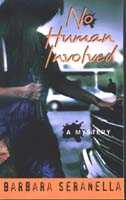
Her first novel.
Bibliography:
* No Human Involved. St. Martin’s, 1997 [Miranda “Munch” Mancini; Los Angeles, CA; 1970s]
* No Offense Intended. Harper, 1999 [Munch Mancini; Los Angeles, CA; 1977]
* Unwanted Company. Harper, 2000 [Munch Mancini; California; 1984]
* Unfinished Business. Scribner, 2001 [Munch Mancini; California; mid-1980s]
* No Man Standing. Scribner, 2002 [Munch Mancini; California; 1980s]
* Unpaid Dues. Scribner, 2003 [Munch Mancini; California; 1980s]
* Unwilling Accomplice. Scribner, 2004 [Munch Mancini; California; 1985]
* An Acceptable Death. St. Martin’s, 2005 [Munch Mancini; Calfornia; 198–]
* Deadman’s Switch. St. Martin’s, 2007 [Charlotte Lyons]
“Misdirection,” which appears in the anthology, Greatest Hits: Original Stories of Hitmen, Hired Guns, and Private Eyes, edited by Robert Randisi, won the 2006 Anthony Award for Best Short Story.
Quoting from the Booklist [starred] review of An Acceptable Death:
“Mancini herself has crawled up from the streets. As an ex-abuse victim, ex-prostitute, ex-biker old lady, ex-drug addict, she is both forever conscious of how lucky she is to be one of the few to escape and how unlucky the many others are who never do; this perspective, plus street smarts, enables her to go undercover convincingly. At this novel’s start, Mancini works as an auto mechanic in Santa Monica, has a nine-year-old daughter, and is involved in a relationship with an undercover narcotics detective.”
The book description for Deadman’s Switch, as taken from the Amazon website:
“Charlotte Lyon can handle a crisis and has made that talent into a lucrative business. She describes it as crisis management, in which she supplies excellent and often unusual advice to suddenly troubled company heads about how to handle the press and the shareholders. And she goes beyond that, whenever she finds it necessary, to get to the bottom of the crisis itself. The job she has now is one of the latter; the derailment of a companys train that has killed both the engineer and a motion picture celebrity. Charlotte refuses to let her own demons — the recent death of her husband and a constantly nagging mother — keep her from going after who caused the accident.”
Mon 22 Jan 2007
A previous entry on this blog was entitled “
Death Noted: ELINORE COWAN STONE (1885-1974).” Mrs. Stone was the author of one published mystery novel,
Fear Rides the Fog (Appleton, 1937). Here are the results of some further investigation into her life:
Some Biographical and Bibliographic Notes on Elinore Cowan Stone
Elinore “Nellie” Rose Cowan was born March 22, 1883 in Adrian, MI, the daughter of John F. and Rebecca Caroline (McClaskey) Cowan. She was the eldest of four children. Her father was a minister.
My choice for her birth year is based mainly on the 1900 US Census record. For it is in that census that people were required to give the month and year of birth. Although women were more inclined to make themselves younger by shaving off a year or two or more when reporting to the census taker, this habit was not restricted to women alone, as will be shown in a forthcoming note on Edwin Dial Torgerson.
Through past ventures into genealogical research, I’d say that if a young lady had not reached her 20th birthday by 1900, then the accuracy of the 1900 Census would be most reliable. Bolstering my selection of her birth date is the fact that in the North Carolina Death Index, her birth date is given as 1883. Such information is usually supplied by a surviving family member, who, in this case, would have been her husband.
Ms. Cowan was educated at Brighton High School (Boston, MA), Mt. Holyoke College (South Hadley, MA), Emerson School of Expression (Boston, MA) and the University of California. She taught at various high schools, private schools, Oahu College in Honolulu, Hawaii and the University of Colorado.
In 1915, she married Clarence Arthur Stone. By 1917, they were living in New Mexico. As presented previously on this blog, the rest of her story is summed up in that newspaper announcement of her reaching her 90th birthday, March 22, 1973. She died on November 30, 1974.
Some Additional Bibliographic Notes.
Contributions to periodicals:
Ain’t She the Beautiful, Woman’s Home Companion, June 1927
Alibi of Salvador, Collier’s Magazine, Aug. 8, 1925
Angela and the Fierce Cally Hope, Woman’s Home Companion, Sep. 1925
The Christmas Lamb, Good Housekeeping, Jan. 1935
Dirty Work at the Crossroads, American Magazine, Aug. 1931
The Fabric of Royalty, Good Housekeeping, Sep. 1926
An Hour Before Dinner, Collier’s Magazine, Dec. 18, 1926
José the Onlocky, Woman’s Home Companion, May 1925
A Little Black Box, Woman’s Home Companion, Jan. 1928
The Making of a Journalist, Woman’s Home Companion, Mar. 1929
The Mama of Manuelito, Century Magazine, Apr. 1923
No Dogs Allowed, The Delineator, July 1931
No Pumpkin Pie for Reckless Guys, Woman’s Home Companion, Nov. 1927
The Phantom of the Wagon Trains, Ladies’ Home Journal, Aug. 1924
A Question of Precedence, Woman’s Home Companion, Mar. 1925
Smoke, Good Housekeeping, July 1929
Somewhere in Russia, Woman’s Home Companion, Jan. 1925
Viva Oncle Sam!, Good Housekeeping, Oct. 1927
What Do We Wear?, Century Magazine, Sep. 1922
White Lilacs, Good Housekeeping, May 1929
Contributions to newspapers:
Note: This part I found most difficult to obtain on-line as most of the newspapers that were presented on-line were partial runs. There were two that were short stories and it was no problem to cite the sources. But in the case of serials, there were only partial runs of the newspaper. The serials were syndicated by NEA Services, Inc. and ran in many different papers throughout the US. But some did not appear on the same dates and some did not appear in other newspapers serviced by NEA. I suppose it was up to each editor to decide which serials would run in his newspaper and when. The stories are chronologically arranged and those that are criminous in nature are denoted by *.
*Applied Science (ss) appeared in Every Week Magazine, in this instance a Sunday
supplement to the Lima (OH) Sunday News, Jan. 14, 1934.
*Two in a Fog (ss) appeared in the Fitchburg (MA) Sentinel, Oct 3, 1936
Belated Holiday (serial), at least Dec. 1937 and Jan . 1938
Love Laughs at the Doctor (serial) Mar. and Apr. 1938
Intern Trouble (serial) July and Aug. 1938
No Time to Marry (serial) Jan. and Feb. 1939
*Murder on the Boardwalk (serial) Aug. and Sep. 1939
*Footsteps in the Fog (serial) June and July 1941
© Victor A. Berch, 2007
Sun 21 Jan 2007
The subtitle for the book will explain more: An Annotated Crime Fiction Bibliography of the Lending Library Publishers: 1936-1967, and there’s a story behind it.
Bill had completed the book before he passed away in 2004, but at the time of his death, he had not yet been able to find a publisher for it. With the manuscript in the hands of mystery writer Bill Pronzini, the search was continued after Bill Deeck’s death, but there were no takers to be found. Some publishers looked at it, some promises were made, but in the end, nothing more happened. When I (this is Steve) offered in mid-2006 to put the entire book online, Bill agreed, and soon thereafter we began the project.

The logo for Phoenix Press, the most prolific of several publishers
for the lending library market.
The website was registered as www.lendinglibmystery.com, some preliminary uploading followed – and that was when events took an unexpected turn. It happened at last year’s Pulpcon, during a conversation that took place between myself and George Vanderburg. George is the man in charge at The Battered Silicon Dispatch Box, publisher of a number of hefty volumes both classic detective fiction reprints and stories from the pulps. While discussing the various projects both he and I were working on, George quickly became convinced of the value of the material in Bill Deeck’s book, and having a strong interest in works of bibliographic interest in the field of crime fiction, he enthusiastically declared his wish to publish it. Obviously there were details to be worked out with Bill Pronzini, but with almost no delay, they were. While an official publication date has yet to be set, the process of getting the book into print, we were advised in mid-December, is in its final stages. At last!
Jump to the present. We’re now heading toward the end of January 2007. Even though Bill Deeck’s book will soon be available, and in the precise format he’d envisioned, we [Bill Pronzini and I] have decided to keep the website up and running. Our intentions are to maintain it as a supplement to the book, not only for now, but for the foreseeable future. Even more, the Internet will allow us to enhance Bill’s book in a way that would be prohibitively expensive to do in printed form: with very little effort, we can upload and display full cover scans of each and every one of the titles which Bill Deeck included and annotated in MA3cAD. Or at least, that’s the goal.
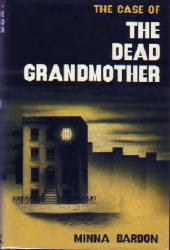
If you were to go here, for example, you would find cover scans of [almost] all of the mysteries published by Phoenix Press between 1936 and 1939. More pages of Phoenix Press covers will be added in due course. The company continued to publish mysteries until 1952. Other publishers whose mysteries are included in MA3cAD are: Hillman-Curl, Arcadia House, Mystery House, Gateway Books, Alliance Press, Alliance Book Corporation, The William Caslon Company, Dodge Publishing Company, William Godwin Inc., and Jonathan Swift Publishers. Cover images for the mystery fiction published by all of these companies will be uploaded as quickly as we can do it.
Keep checking with George’s The Battered Silicon Dispatch Box website as to its availability. I’ll be sure to let you know here, of course, as soon as it’s ready. In the meantime, check out the link in the paragraph above, and enjoy the covers!
PS. I almost forget. To read Bill Pronzini’s delightful account (if not deconstruction) of Phoenix Press and the mysteries they published, go here.
Sat 20 Jan 2007
I didn’t realize that Art Buchwald, the world-famous humorist who died three days ago, was among his other accomplishments, a crime fiction writer. I haven’t asked Al Hubin, author of Crime Fiction IV, for his opinion yet, but as of this evening, Mr. Buchwald has not been honored with an entry in his massive, all-inclusive bibliography of our field.
Let me make a case for his inclusion, if I may, based on the following paragraph which I read in yesterday or today’s issue of the New York Times:
“A guy showed up in my office covered with bandages and blood and told me he was a recent graduate of Sing Sing,” Mr. [Ben] Bradlee [former editor of the
Washington Post] said. “He had done time for murder and was broke. He became a thorn in my side, and I got sick of him, so I sent him to Buchwald, just to get him out of my office. Art locked him up in a room and wrote a book about him,
A Gift From the Boys. The guy had been deported and his mob friends gave him a girl as a goodbye present.”
The novel, by the way, published in 1958, became the basis of the 1960 movie Surprise Package with Yul Brynner and Mitzi Gaynor (as the Gift).
[The illustration on the jacket is by Dedini,
a cartoonist often spotted in
New Yorker magazine.]
The paragraph in the Times was interesting but hardly conclusive. I searched online for more evidence to back my case. From Bloomberg.com:
The story centered on mobsters who were deported from the U.S. to Italy, where Buchwald traveled to interview organized crime figure Charles “Lucky” Luciano in Naples.
Well, Mr. Buchwald was talking to the right people to help write a crime novel, all right, but I couldn’t come up with a more useful description of the book than what I have so far. Maybe I’d have better luck finding a plot outline of the movie, I thought.
From Time magazine [Nov. 14, 1960]:
Surprise Package (Columbia) is stuffed with expensive ingredients: Yul Brynner, Mitzi Gaynor, Noel Coward in front of the camera, Director Stanley (
Seven Brides for Seven Brothers) Donen behind it plus a script by Harry (
Reclining Figure) Kurnitz based on a novel (
A Gift from the Boys) by Columnist Art Buchwald. But as far as entertainment is concerned,
Package contains only what is known in show business as a bomb. Director Donen clearly intended to tell a shaggy-dog story the way John Huston did in his hilarious
Beat the Devil but unfortunately, Donen’s dog turns out to be all bark and no bite. The hero (Brynner) is a big-time hood deported from the U.S. to his native Greece and confined by the Greek government to a small Aegean island. The story evolves around his attempt to get back in the money by relieving an exiled king (Noel Coward) of his million-dollar crown. Revolving ever more tediously, it goes down the drain in a clutter of words.
Package is perhaps the year’s talkiest talkie. Coward: “It’s amazing how a girl so dumb that if you say hello she’s stuck for an answer can reel off a three-hour lecture on why wild mink is better.” Brynner, contemplating a statue of a discus thrower: “What sort of a country is dis? Puttin’ up a monument of a guy stealin’ hubcaps!”
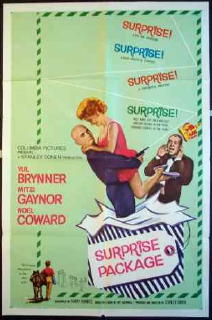
So OK, Time didn’t like the movie, but there are points of the plot that are crime-related, wouldn’t you agree? Moving on, here is something extremely interesting I found on TVHeads.com.
It was also during this period (sometime between 1948 and 1951) Buchwald was rumored and reported to have a very short lived affair with American actress Marilyn Monroe. The affair is said to have only lasted a few weeks, and it was said that Buchwald introduced Marilyn to Judaism (to which she later converted). Marilyn is said to be the basis in part for a character in Buchwald’s novel
A Gift From The Boys published in 1958.
Now I agree that this has nothing to do with my conjecture that Mr. Buchwald’s novel is a work of crime fiction, but if the TVHeads rumor is true, why all I can do is nod my head in agreement.
Perhaps we should get serious for a moment. Here is my final piece of evidence, a comment from a semi-anonymous poster on IMDB.com:
“This is a caper film involving a deported U.S. gangster played by Yul Brynner now living on a Greek island trying to steal the crown of the exiled King of Anatolia played by Coward. Along for the ride is Mitzi Gaynor as Brynner’s moll and the baddie played by George Coulouris from the People’s Republic of Anatolia, the gang that overthrew the king. The director is Stanley Donen from a novel by humorist Art Buchwald.
“Brynner is terribly miscast in his part. A gangster I can believe him as, but he just has no flair for comedy. There were some comic moments in the King and I, but that’s overall, a serious part. Coward looks bored by the whole thing, I wish he had scripted and directed it also and he probably wished he did too. George Coulouris was his usual menacing self.”
Well, what do you think? Is Mr. Buchwald in, or is he out?
[UPDATE: 01-21-07] An email reponse from Al Hubin, excerpted to refer only to my presentation above:
Steve,
I’m convinced, though at this stage I’m inclined (for my next Addenda installment, Part 10) to use a dash [to indicate marginal crime content]. Good work on your part!
Best,
Al
>> My reply? I agree 100 percent. I couldn’t convince even myself that the book’s more than a marginal entry, but I’m still glad to know that Mr. Buchwald is in.
Fri 19 Jan 2007
At the present time, the entry for mystery writer John Dellbridge in Crime Fiction IV, by Allen J. Hubin, looks like this:
DELLBRIDGE, JOHN (1887-?)
* * * -The Moles of Death (Diamond, 1927, hc) [India]
* * * Sons of Tumult (Long, 1928, hc) [Pakistan]
* * * The Honourable Sir John (Long, 1929, hc) [England]
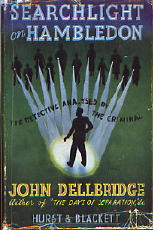 * * * Searchlight on Hambledon (Hurst, 1947, hc) [Rupert Hambledon; England] Story collection:
* * * Searchlight on Hambledon (Hurst, 1947, hc) [Rupert Hambledon; England] Story collection:
• Clowns Are Serious Sometimes • ss
• Conversation Piece with Postscript • ss
• The Defeat of Hambledon • ss
• Devastating Sanity • ss
• Entirely Self Made • ss
• The Fire That Was Quenched • ss
• Horses Can’t Be Trusted • ss
• Last of the Screwleighs • ss
• Letter to His Bishop • ss
• Modern Messalina • ss
• Ronnie the Rat • ss
* * * Unfit to Plead (Hurst, 1949, hc) [Rupert Hambledon; England]
* * * The Lady in the Wood (Hurst, 1950, hc) [Rupert Hambledon; England]
British bookseller Jamie Sturgeon, however, has discovered the website for The University of the West Indies at St. Augustine, Trinidad & Tobago, where the papers of Frederick Joseph De Verteuil are stored.
On the page describing their holdings for him it states that De Verteuil was born in Trinidad in 1887, and that he “went to England at the age of fourteen in 1901 and later qualified as a lawyer at Gray’s Inn. He practised as a barrister in India for several years and later returned to England where he continued practising law until he was debarred from practice due to misrepresenting his clients in court. [See FOOTNOTE.] He then became a little known writer of novels and short stories, historical works and semi-scientific commentaries. He wrote under three different pseudonyms: John Dellbridge, Freddy Bannister and Francis Vere.”
Neither Bannister nor Vere are in CFIV, but John Dellbridge’s identity has clearly now been revealed.
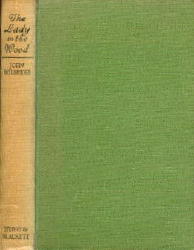
Jamie emailed Al Hubin with his discovery, who in turn did some followup investigating:
Too bad the site doesn’t give a death date. I’ll have to do a little trolling on the real name and see if I can find it.
[Later] The only reference (other than the one Jamie gives) that turned up in a google search was a wedding notice for one Carl Frederick de Verteuil, which mentions that his father (a novelist!) retired as managing director of cruise ship newspapers published by the Thomas Skinner company in Toronto! The groom’s age (35) makes it virtually impossible that he was the son of “Dellbridge” (who would have been some 88 years old when Carl was born), but could he be the grandson? Incidentally, there’s no trace of anyone name de Verteuil in the Canada National Catalogue. But in the British Library Catalogue is a book by one Anthony de Verteuil,
The de Verteuils of Trinidad 1797-1997, which might very likely shed further light on “Dellbridge” and perhaps others And Frederick Joseph de Vertueil (almost certainly “Dellbridge”) published an autobiographical book under his real name in 1938,
Fifty Wasted Years, which might also make interesting reading And there’s a Carl de Verteuil with several novels ca.1950-1960 (the groom’s father?). Anthony de Verteuil has quite a number of books going back to 1973 though they don’t seem to be novels. All very interesting!
And here is where the matter stands. Even if nothing further is found, we now know considerably more about on the pseudonymous John Dellbridge than we did before. As for Rupert Hambledon, there’s nothing known about him at the moment, but there will be soon. I (this is Steve) have purchased a copy of The Lady in the Wood, pictured above, and it’s now on its way to me from England. When I know more, you’ll read about it here.
[UPDATE: 01-20-07] Here’s a short note received by email from John Herrington:
Hi Steve,
It appears that Francis Vere was used on a 1952 novel
Don Ricardo and the 1955
Salt in Their Blood about Dutch admirals. There are also some 1950s works on Piltdown Man and evolution which have the same name as author. Coincidence or same writer I know not.
Cannot find anything by Freddy Bannister. A Google search is hampered by the fact that that was the name of the man who organised the Knebworth concerts.
And who was the Frederick Benedict De Verteuil who wrote the 1949 Almost Glory as F. Benedict? Presume he must be related.
Regards
John
[UPDATE: 04-04-07] Taken from an email from Carl de Verteuil, mentioned above, who also has two posts in the comments section —
Steve,
My grandfather died in 1963 (I don’t have the exact date) but it was sometime in the autumn — at about the same time as JFK and Aldous Huxley !
I’ll see if I can gather some more information from my uncle “Cook” (son of Frederick) about his mystery writing. He was a prolific author and is well regarded in his native Trinidad (the de Verteuils were one of the French families to have settled there after the French revolution).
Unfortunately, he wrote under several different names which probably didn’t help his cause too much. Uncle Cook (who is also referred to in your blog) is now 88 years old and was himself an author although not of mystery books.
I’ll see what I can find and will get back to you.
[FOOTNOTE.] 10-04-08. John Eggeling sent me this information about De Verteuil’s legal problems in an email a few weeks ago, but I’ve only now been able to add it to this post. Says John:
“In July 1938 Frederick Joseph De Verteuil was found guilty of conspiracy and fraud and he was sentenced to 5 years in prison. A report of his appeal, which failed, appeared in The Times for November 29, 1938.”
John sent me an attachment containing a copy of that appeal, which is far too long for me to reproduce here. If anyone’s interested, email me, and I should be able to forward it on to you.
Fri 19 Jan 2007
Posted by Steve under
Authors ,
Awards1 Comment
The following was taken verbatim this morning from the MWA website.
As usual — should I reveal this? — I have read or watched very few of the books, stories, plays or movies honored below, but if I may insert a personal aside, I somehow have the feeling that one of the nominees is especially pleased. I don’t blame him. Congratulations to all!
2007 Edgar® Nominees
Best Novel • First Novel • Paperback Original • Critical/Biographical
Fact Crime • Short Story • Young Adult • Juvenile • Play
TV Episode Teleplay • Motion Picture Screenplay
Robert L. Fish Memorial • Grand Master • Raven • Mary Higgins Clark
Mystery Writers of America is proud to announce on the 198th anniversary of the birth of Edgar Allan Poe, its Nominees for the 2007 Edgar Allan Poe Awards, honoring the best in mystery fiction, non-fiction, television and film published or produced in 2006. The Edgar Awards will be presented to the winners at our 61st Gala Banquet, April 26, 2007 at the Grand Hyatt Hotel, New York City.
Best Novel Nominees
* The Pale Blue Eye by Louis Bayard (HarperCollins)
* The Janissary Tree by Jason Goodwin (Farrar, Straus and Giroux)
* Gentleman and Players by Joanne Harris (HarperCollins – William Morrow)
* The Dead Hour by Denise Mina (Hachette Book Group – Little, Brown and Company)
* The Virgin of Small Plains by Nancy Pickard (Random House – Ballantine Books)
* The Liberation Movements by Olen Steinhauer (St. Martin’s Minotaur)
Best First Novel By An American Author
* The Faithful Spy by Alex Berenson (Random House)
* Sharp Objects by Gillian Flynn (Crown – Shaye Areheart Books)
* King of Lies by John Hart (St. Martin’s Minotaur – Thomas Dunne Books)
* Holmes on the Range by Steve Hockensmith (St. Martin’s Minotaur)
* A Field of Darkness by Cornelia Read (Warner Books – Mysterious Press)
Best Paperback Original
* The Goodbye Kiss by Massimo Carlotto (Europa Editions)
* The Open Curtain by Brian Evenson (Coffee House Press)
* Snakeskin Shamisen by Naomi Hirahara (Bantam Dell Publishing – Delta Books)
* The Deep Blue Alibi by Paul Levine (Bantam Dell Publishing – Bantam Books)
* City of Tiny Lights by Patrick Neate (Penguin Group – Riverhead Books)
Best Critical/Biographical
* Unless the Threat of Death is Behind Them: Hard-Boiled Fiction and Film Noir by John T. Irwin (Johns Hopkins University Press)
* The Science of Sherlock Holmes: From Baskerville Hall to the Valley of Fear by E.J. Wagner (John Wiley & Sons)
Best Fact Crime
* Strange Piece of Paradise by Terri Jentz (Farrar, Straus & Giroux)
* A Death in Belmont by Sebastian Junger (W.W. Norton and Co.)
* Finding Amy: A True Story of Murder in Maine by Capt. Joseph K. Loughlin & Kate Clark Flora (University Press of New England)
* Ripperology: A Study of the World’s First Serial Killer by Robin Odell (The Kent State University Press)
* The Beautiful Cigar Girl: Mary Rogers, Edgar Allan Poe and the Invention of Murder by Daniel Stashower (Dutton)
* Manhunt: The 12-Day Chase for Lincoln’s Killer by James L. Swanson (HarperCollins – William Morrow)
Best Short Story
* “The Home Front” – Death Do Us Part by Charles Ardai (Hachette Book Group – Little, Brown and Company)
* “Rain” – Manhattan Noir by Thomas H. Cook (Akashic Books)
* “Cranked” – Damn Near Dead by Bill Crider (Busted Flush Press)
* “White Trash Noir” – Murder at the Foul Line by Michael Malone (Hachette Book Group – Mysterious Press)
* “Building” – Manhattan Noir by S.J. Rozan (Akashic Books)
Best Young Adult
* The Road of the Dead by Kevin Brooks (Scholastic – The Chicken House)
* The Christopher Killer by Alane Ferguson (Penguin YR – Sleuth/Viking)
* Crunch Time by Mariah Fredericks (Simon & Schuster – Richard Jackson Books/Atheneum)
* Buried by Robin Merrow MacCready (Penguin YR – Dutton Children’s Books)
* The Night My Sister Went Missing by Carol Plum-Ucci (Harcourt Children’s Books)
Best Juvenile
* Gilda Joyce: The Ladies of the Lake by Jennifer Allison (Penguin Young Readers – Sleuth/Dutton)
* The Stolen Sapphire: A Samantha Mystery by Sarah Masters Buckey (American Girl Publishing)
* Room One: A Mystery or Two by Andrew Clements (Simon & Schuster Books for Young Readers)
* The Bloodwater Mysteries: Snatched by Pete Hautman & Mary Logue (Penguin Young Readers – Sleuth/Putnam)
* The Case of the Missing Marquess: An Enola Holmes Mystery by Nancy Springer (Penguin Young Readers – Philomel/Sleuth)
Best Play
* Sherlock Holmes: The Final Adventure by Steven Dietz (Arizona Theatre Company)
* Curtains by Rupert Holmes (Ahmanson Theatre)
* Ghosts of Ocean House by Michael Kimball (The Players’ Ring)
Best Television Episode Teleplay
* The Closer – “Blue Blood”, Teleplay by James Duff & Mike Berchem (Turner Network Television)
* Dexter – “Crocodile”, Teleplay by Clyde Phillips (Showtime)
* House – “Clueless”, Teleplay by Thomas L. Moran (Fox/NBC Universal)
* Life on Mars – Episode 1, Teleplay by Matthew Graham (BBC America)
* Monk – “Mr. Monk Gets a New Shrink”, Teleplay by Hy Conrad (USA Network/NBC Universal)
Best Motion Picture Screen Play
* Casino Royale, Screenplay by Neal Purvis, Robert Wade & Paul Haggis, based on novel by Ian Fleming (MGM)
* Children of Men, Screenplay by Alfonso Cuarón, Timothy J. Sexton, David Arata, Mark Fergus & Hawk Ostby, based on a novel by P.D. James (Universal Pictures
* The Departed, Screenplay by William Monahan (Warner Bros. Pictures)
* The Good Shepherd, Teleplay by Eric Roth, based on a novel by Joseph Kanon (Universal Pictures)
* Notes on a Scandal, Screenplay by Patrick Marber (Scott Rudin Productions)
Robert L. Fish Memorial Award
* William Dylan Powell “Evening Gold” – EQMM November 2006 (Dell Magazines)
Grand Master
Stephen King
Raven
* Books & Books (Mitchell Kaplan, owner)
* Mystery Loves Company Bookstore (Kathy & Tom Harig, owners)
The Simon & Schuster – Mary Higgins Clark Award
* Bloodline by Fiona Mountain (St. Martin’s Minotaur)
Thu 18 Jan 2007
I’ve just received what has to be a first, or for me personally, I know it is. As perhaps you already know, Berkley is in the process of publishing a new mystery series by “debut” author Sarah D’Almeida, beginning with Death of a Musketeer, in which Alexander Dumas’s famous characters, Athos, Porthos, Aramis and D’Artagnan, add sleuthing duties to their usual ones of romantic adventure and royal intrigue. Yes, indeed, the Three Musketeers are back.
That’s hardly surprising. Over the past ten years or so mystery writers have been using the talents of loads of other fictional characters as detectives — even those you would never think of as a detective — and plenty of real life notables from the past as well. Who is there, if I may ask, who lived at the same time as Sherlock Holmes, fictional or otherwise, who hasn’t yet been involved in a case with the great detective?
No, what’s unusual is the promotional item for the book that came in today’s mail. I didn’t get the book today– it came out in November, and it’s stacked somewhere in my TBR pile — but what I did get is a short preview of the story in comic book form. It’s six pages long, and the art is by Rob Dumuhosky. To my eye, it’s very well done. It may come out too small to be readable, but I think you can get a fairly good idea of what it looks like from the image below.
For a better look at the artist’s work, go here.
When I referred to the author of this new series in my first paragraph up above, I put the word debut in quotes. A little googling quickly reveals that Sarah D’Almeida is in reality well-known fantasy writer Sarah A. Hoyt. This is not surprising. It’s only a short step from constructing a world of pure fantasy to writing a novel taking place in the past. The skills involved are pretty much the same. In either case, the task is to take the reader into another world that he or she is unfamiliar with, and be convincing about it.
I haven’t read the book yet, so I can’t tell you how successful the author’s been in transforming the trio (plus one) into a group of working detectives, but the book does sound intriguing, and beyond a doubt, this is certainly the first comic book that I’ve received to promote one.
And, oh yes, there were the usual bookmarks that came along with a small stack of the booklets, and — of course! — a small candy bar.
[UPDATE: 01-18-07] After seeing the post above, Sarah Hoyt emailed me and said:
Dear Steve,
Thanks for the mention. 🙂
Actually, I always wanted to write mystery. It just worked out fantasy first. D’Almeida is my maiden name.
Oh, and I’ve JUST sold books 4 to 6 on the series, so there will be at least that many. 🙂
Sarah
I replied, wishing her well with the series and asking if I might post her comments as an update to this blog entry. Her response came right away:
Steve,
Certainly. Don’t know if you want to post this but… The first book was more bound by certain self-imposed strictures, like the fact that I wanted to evoke enough of the plot to attract people who’d only seen the movies of the Three Musketeers. It’s ALMOST (though not quite) Musketeer’s mystery fan fic. So some incidents will be startlingly familiar.
After that, each book becomes more of an historical mystery in its own right, though still featuring the Three Musketeers. I purposely tried to keep the language simple yet evocative enough. (My fantasy series featuring Shakespeare suffered from too much authenticity, perhaps, making it — on reread, several years later — a little too difficult to follow.)
I had a wicked level of fun writing the “footnotes” on what M. Dumas got “wrong.”
All in all, the series is lots of fun to play in, so I’m thrilled about the sale. The books are, in order:
Death of A Musketeer,
The Musketeer’s Seamstress,
The Musketeer’s Apprentice,
The Musketeer’s Inheritance,
The Musketeer’s Servant and
The Musketeer’s Confessor.
Oh, and the first book sold to the bookclub, though I have no details yet. 🙂
As Sarah A. Hoyt I’m doing a fantasy series for Baen (and soon an sf series as well, hopefully) starting with
Draw One In The Dark, which came out in November (urban fantasy) and a fantasy series for Bantam (first book to be delivered to editor this month) which takes place in an alternate, magical British Empire (
Heart of Light in Africa;
Soul of Fire in India;
Heart and Soul in China).
Sarah
To which I say, Sarah, please take a break from the keyboard every once in a while, will you? This is all terrific news. Congratulations on staying so busy!
Wed 17 Jan 2007
Posted by Steve under
AuthorsNo Comments
You start out as a reader, you love mysteries and maybe you know someone else you does and perhaps more likely, you don’t. The authors, the people who write the books, why they’re in a category by themselves. But you write to some of them, you meet other fans and you hang around them long enough and before you know it, sooner or later, some of them go professional and become mystery writers themselves. But you knew them before they went pro, and somehow that puts them into a separate category.
The first fan I knew who went down this route was Bill Crider, whose contribution to the Nick Carter canon, The Coyote Connection, came out in 1981. There have been a number of others in between, but I’d like to bring to your attention the latest, Ed Lynskey.
Ed was an contributing editor to both the print version of Mystery*File, and when I took it digital, the M*F website. He specialized in interviews with mystery writers then, and if they were no longer with us, overviews of their careers. Authors in either or both categories are Robert Wade, Ed Lacy, Stephen Greenstreet, and Dennis Lynds.
In the past year or so Ed, as I said up above, has turned author. His first book was a private eye novel entitled The Dirt Brown Derby (Mundania Press, 2006). No one should have been surprised that his first novel was a PI affair, given the authors above whose work has he’s obviously enjoyed.
Frank Johnson is the private eye who’s in The Dirt Brown Derby, and now he has a second case under his belt, or he will have in March, a book called The Blue Cheer (PointBlank, 2007).
Publisher’s Weekly has a review of it, and I quote:
The Blue Cheer
Ed Lynskey. Point Blank (www.pointblankpress.com), $12.95 paper (224p) ISBN 978-0-8095-5667-0
Set in the remote mountains of West Virginia, this gritty contemporary detective novel, Lynskey’s second to feature former PI Frank Johnson (after 2006’s The Dirt-Brown Derby), will remind many of such masters of hard-boiled prose as Loren Estleman. Johnson has sought to still the memories of a deadly encounter with the Ku Klux Klan by retreating to the Appalachian town of Scarab, where people—and friends—are few and far between. Johnson witnesses what appears to be a Stinger missile strike against an unmanned aerial drone hovering above his yard, and he calls on his closest local companion, Old Man Maddox, a retired CIA agent. When the pair pursue the mystery with the local sheriff, a cascade of violence overwhelms the quiet community—murders that may be connected with a shadowy local racist cult known as the Blue Cheer. Despite a somewhat predictable resolution, the first-rate writing will leave readers eager to see more of Johnson. (Mar.)
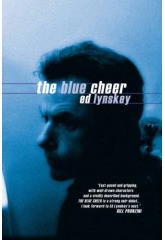
Here’s a bit more about Ed, taken from the PointBlank website:
Ed Lynskey is a crime fiction writer and poet living near Washington, D.C. His first two books are mysteries featuring his PI Frank Johnson:
THE DIRT-BROWN DERBY (Mundania Press, 2006) and
THE BLUE CHEER (Point Blank/Wildside Press, 2007). Two sequels include
PELHAM FELL HERE (Mundania Press, 2007) and
TROGLODYTES (Mundania Press, 2008). His work has been anthologized by St. Martin’s Press and University of Virginia Press. His short fiction has appeared in
Alfred Hitchcock Mystery Magazine. His poems have appeared in
The Atlantic Monthly. His reviews have appeared in
New York Times Book Review and
Washington Post. His mystery fiction has been praised by Linda Fairstein, Ken Bruen, Bill Pronzini, and John Lutz.
What more can I add? Way to go, Ed!
« Previous Page — Next Page »
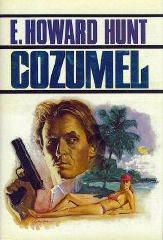
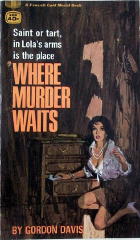
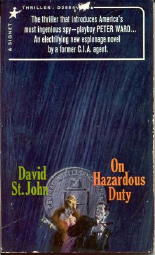

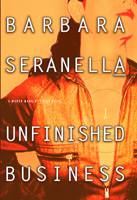

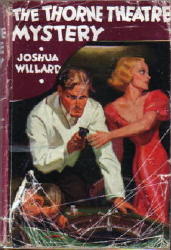
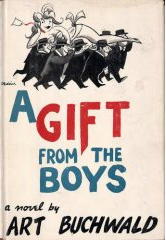

 * * * Searchlight on Hambledon (Hurst, 1947, hc) [Rupert Hambledon; England] Story collection:
* * * Searchlight on Hambledon (Hurst, 1947, hc) [Rupert Hambledon; England] Story collection:

